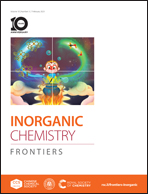Orange/cyan emissive sensors of Sb3+ for probing water via reversible phase transformation in rare-earth-based perovskite crystals†
Abstract
A facile strategy for water probing with visible perception is particularly important for water transport, ecosystem sustainability, and the ocean industry. Here, we have developed a simple technology to probe water content by using the response of the orange/cyan luminescence color of Sb3+ emitted from the two novel rare-earth-based perovskite crystals Rb2ScCl5·H2O and Rb3ScCl6. The reversible transformation between Rb2ScCl5·H2O and Rb3ScCl6 accompanied by the significant visible perception of the change of the luminescence color can be realized through the dehydration/hydration process in air. In addition to the favorable sensitivity to water, an in-depth study shows that the highly efficient photoluminescence (PL) of Sb3+ in both Rb2ScCl5·H2O and Rb3ScCl6 host matrixes arises from the self-trapped excitons (STEs) rather than the 5s2–5s15p1 transition of Sb3+ according to the density functional theory (DFT) calculation. It can be anticipated that this study will provide new insights into the luminescence mechanism of Sb3+ in perovskite crystals and a potential application in a sensitive sensor for probing water content.



 Please wait while we load your content...
Please wait while we load your content...